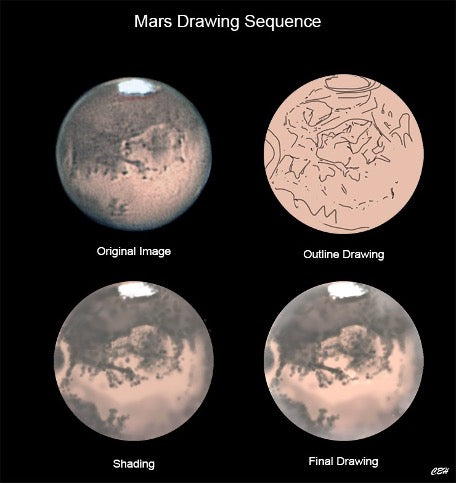A great challenge that will enhance your understanding of Mars is to find and draw what you see through your telescope of the albedo features. A Mars albedo map will aid you in identifying these features.

Making drawing of your observations of the planet Mars is not as difficult as it seems. An observer typically produces a 42 to 50 millimeter blank disc in order to render and observation of the planet Mars.
The first and vital step in producing an accurate drawing of the planet Mars is a carefully rendered outline of the main albedo features (dark and light features) visible over the disc of the planet.
An observer may decide to divide the visible disc into quarters (or eights) and place the albedo features visible within each quarter/eights. After careful review of the outline produced the observer begins the process of shading the darkest albedo features visible then gradually adding the more subtle shadings visible and finally rendering the lightest (brightest) regions of the planet (be careful to leave the brightest features of the planet (e.g. North or South Polar Caps and limb clouds) free of pencil marks).
The object of the drawing is not to produce a work of art but to render what is visible over the surface of the planet at a specific period of time as well as train the observer to detect fainter detail over time as they study the delicate surface and atmosphere of the red planet. The important thing is for the observer to make the process a fun one!
- Mars
- Oppositions of Mars
- Mars in Retrograde
- Weather on Mars
- Observing Mars With a Telescope
- Learning to Draw Mars Albedo Features
About the author:
 Ambassador Carlos Hernandez has contributed his planetary observations to worldwide organizations including The Association of Lunar and Planetary Observers (ALPO, United States), British Astronomical Association (BAA, Great Britain), Oriental Astronomical Association (OAA, Japan), and many other excellent planetary amateur astronomer groups over many decades.
Ambassador Carlos Hernandez has contributed his planetary observations to worldwide organizations including The Association of Lunar and Planetary Observers (ALPO, United States), British Astronomical Association (BAA, Great Britain), Oriental Astronomical Association (OAA, Japan), and many other excellent planetary amateur astronomer groups over many decades.

